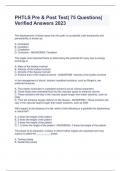Phtls pre test stuvia - Study guides, Class notes & Summaries
Looking for the best study guides, study notes and summaries about Phtls pre test stuvia? On this page you'll find 3 study documents about Phtls pre test stuvia.
All 3 results
Sort by

-
PHTLS Pre & Post Test Exam – With Questions & Answers 100% Correct
- Exam (elaborations) • 15 pages • 2023
-
Available in package deal
-
- $10.99
- + learn more
PHTLS Pre & Post Test Exam – With Questions & Answers 100% CorrectPHTLS Pre & Post Test Exam – With Questions & Answers 100% CorrectPHTLS Pre & Post Test Exam – With Questions & Answers 100% CorrectPHTLS Pre & Post Test Exam – With Questions & Answers 100% Correct The displacement of tissue away from the path of a projectile, both temporarily and permanently, is known as: A. Conization B. Cavitation C. Crepitation D. Contusion - ANSWER - B. Cavitation The single most import...

-
PHTLS Pre-Test 9th edition Version 1NV Correct 100%
- Exam (elaborations) • 9 pages • 2023
-
- $9.99
- + learn more
When caring for a trauma patient, a principle is what is necessary for patient improvement or survival. A preference is how the principle is achieved and depends upon four factors. The factors used to establish the preference in treating the patient include all except: a) Condition of the patient b) Equipment available c) Situation that exists d) Research information - ANSWERSResearch information Approximately 20% of all child abuse is the result of intentional burning. The majority of t...

-
PHTLS Pre & Post Test| 75 Questions| Verified Answers 2023
- Exam (elaborations) • 15 pages • 2023
-
- $9.99
- + learn more
The displacement of tissue away from the path of a projectile, both temporarily and permanently, is known as: A. Conization B. Cavitation C. Crepitation D. Contusion - ANSWERSB. Cavitation The single most important factor in determining the potential for injury due to energy exchange is: A. Mass of the bodies involved B. Velocity of the bodies involved C. Density of the tissues involved D. Surface area of the impact involved - ANSWERSB. Velocity of the bodies involved ...

Do you wonder why so many students wear nice clothes, have money to spare and enjoy tons of free time? Well, they sell on Stuvia! Imagine your study notes being downloaded a dozen times for $15 each. Every. Single. Day. Discover all about earning on Stuvia


